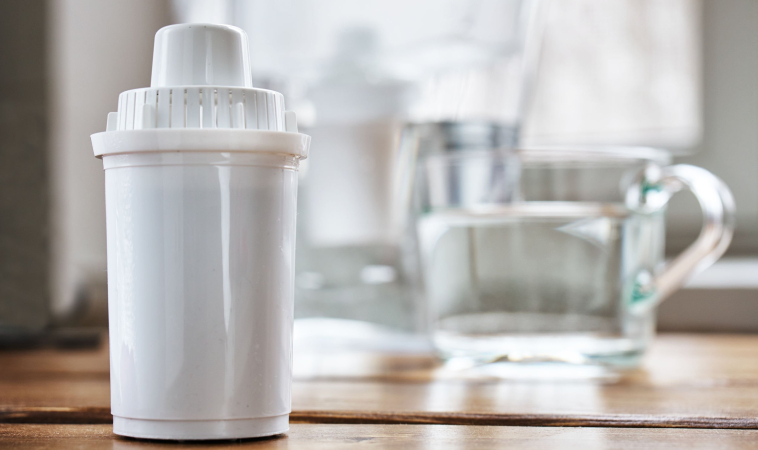The water filter on your refrigerator door, the pitcher-style filter you keep inside the fridge and the whole-house filtration system you installed last year may function differently and have vastly different price tags, but they have one thing in common.
Water filters may not remove all of the drinking water contaminants you’re most concerned about
A new study by scientists at Duke University and North Carolina State University finds that – while using any filter is better than using none – many household filters are only partially effective at removing toxic perfluoroalkyl substances, commonly known as PFAS, from drinking water. A few, if not properly maintained, can even make the situation worse.
76 point-of-use filters and 13 point-of-entry or whole-house systems were tested
“We tested 76 point-of-use filters and 13 point-of-entry or whole-house systems and found their effectiveness varied widely.
All of the under-sink reverse osmosis and two-stage filters achieved near-complete removal of the PFAS chemicals we were testing for. In contrast, the effectiveness of activated-carbon filters used in many pitcher, countertop, refrigerator and faucet-mounted styles was inconsistent and unpredictable. The whole-house systems were also widely variable and in some cases actually increased PFAS levels in the water,” said Heather Stapleton, the Dan and Bunny Gabel Associate Professor of Environmental Health at Duke’s Nicholas School of the Environment.
‘Home filters only a stopgap’
“Home filters are really only a stopgap,” said Detlef Knappe, the S. James Ellen Distinguished Professor of Civil, Construction and Environmental Engineering at NC State, whose lab teamed with Stapleton’s to conduct the study. “The real goal should be control of PFAS contaminants at their source.”
Perfluoroalkyl substances (PFAS)
PFAS have come under scrutiny in recent years due to their potential health impacts and widespread presence in the environment, especially drinking water. Exposure to the chemicals, used widely in fire-fighting foams and stain- and water-repellents, is associated with various cancers, low birth weight in babies, thyroid disease, impaired immune function and other health disorders. Mothers and young children may be most vulnerable to the chemicals, which can affect reproductive and developmental health.
Some scientists call PFAS “forever chemicals” because they persist in the environment indefinitely and accumulate in the human body. They are now nearly ubiquitous in human blood serum samples, Stapleton noted.
First study to examine the PFAS-removal efficiencies of point-of-use filters in a residential setting
The researchers published their peer-reviewed findings Feb. 5th in Environmental Science & Technology Letters. It’s the first study to examine the PFAS-removal efficiencies of point-of-use filters in a residential setting.
They analyzed filtered water samples from homes in Chatham, Orange, Durham and Wake counties in central North Carolina and New Hanover and Brunswick counties in southeastern N.C. Samples were tested for a suite of PFAS contaminants, including three perfluoroalkal sulfonic acids (PFSAs), seven perfluoroalkyl carboxylic acids (PFCAs) and six per- and poly-fluoroalkyl ether acids (PFEAs). GenX, which has been found in high levels in water in the Wilmington area of southeastern N.C., was among the PFEAs for which they tested.
Key takeaways include
- Reverse osmosis filters and two-stage filters reduced PFAS levels, including GenX, by 94% or more in water, though the small number of two-stage filters tested necessitates further testing to determine why they performed so well.
- Activated-carbon filters removed 73% of PFAS contaminants, on average, but results varied greatly. In some cases, the chemicals were completely removed; in other cases they were not reduced at all. Researchers saw no clear trends between removal efficiency and filter brand, age or source water chemical levels. Changing out filters regularly is probably a very good idea, nonetheless, researchers said.
- The PFAS-removal efficiency of whole-house systems using activated carbon filters varied widely. In four of the six systems tested, PFSA and PFCA levels actually increased after filtration. Because the systems remove disinfectants used in city water treatment, they can also leave home pipes susceptible to bacterial growth.
‘Under-sink reverse osmosis filter is the most efficient system’
“The under-sink reverse osmosis filter is the most efficient system for removing both the PFAS contaminants prevalent in central N.C. and the PFEAs, including GenX, found in Wilmington,” Knappe said. “Unfortunately, they also cost much more than other point-of-use filters. This raises concerns about environmental justice, since PFAS pollution affects more households that struggle financially than those that do not struggle.”
Source:
- Herkert, N.J., et al. (2020) Assessing the Effectiveness of Point-of-Use Residential Drinking Water Filters for Perfluoroalkyl Substances (PFASs). Environmental Science & Technology Letters. doi.org/10.1021/acs.estlett.0c00004.
 Razi Berry is the founder and publisher of the journal Naturopathic Doctor News & Review, which has been in print since 2005, and the premier consumer-faced website of naturopathic medicine, NaturalPath. She is the host of The Love is Medicine Project docuseries, The Natural Cancer Prevention Summit, The Heart Revolution-Heal, Empower and Follow Your Heart, and the popular 10-week Sugar Free Summer program. From a near death experience as a young girl that healed her failing heart, to later overcoming infertility and Chronic Fatigue Syndrome and Fibromyalgia through naturopathic medicine, Razi has lived the mind/body healing paradigm. Her projects uniquely capture the tradition and philosophy of naturopathy: The healing power of nature, the vital life force in every living thing and the undeniable role that science and mind/body medicine have in creating health and overcoming dis-ease. You can follow Razi on social media: Facebook at Razi Berry, Instagram at Razi.Berry and join the Love is Medicine group to explore the convergence of love and health. Look for more, and listen to more Love is Medicine podcast episodes here.
Razi Berry is the founder and publisher of the journal Naturopathic Doctor News & Review, which has been in print since 2005, and the premier consumer-faced website of naturopathic medicine, NaturalPath. She is the host of The Love is Medicine Project docuseries, The Natural Cancer Prevention Summit, The Heart Revolution-Heal, Empower and Follow Your Heart, and the popular 10-week Sugar Free Summer program. From a near death experience as a young girl that healed her failing heart, to later overcoming infertility and Chronic Fatigue Syndrome and Fibromyalgia through naturopathic medicine, Razi has lived the mind/body healing paradigm. Her projects uniquely capture the tradition and philosophy of naturopathy: The healing power of nature, the vital life force in every living thing and the undeniable role that science and mind/body medicine have in creating health and overcoming dis-ease. You can follow Razi on social media: Facebook at Razi Berry, Instagram at Razi.Berry and join the Love is Medicine group to explore the convergence of love and health. Look for more, and listen to more Love is Medicine podcast episodes here.

















